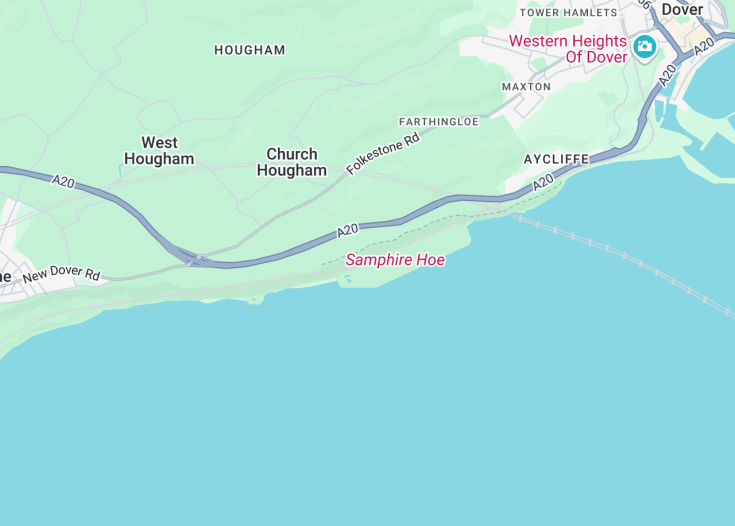The White Cliffs of Dover, iconic chalk cliffs overlooking the English Channel, have stood as symbols of hope and freedom across centuries. These natural wonders are not only a spectacular sight but also hold great historical significance, having been the frontline defense in numerous historical conflicts. With their lush greenery atop and the bustling port below, the cliffs offer visitors a unique blend of natural beauty and historical richness, making them a must-visit destination for history enthusiasts and nature lovers alike.
To fully appreciate the panoramic views of the English Channel, visit on a clear day. Fog and rain can significantly obscure the stunning vistas.
Consider taking a guided historical tour to learn about the pivotal role the cliffs played during World War II. It enriches the experience significantly.
White Cliffs of Dover: A Symbol of Hope and Strength
The White Cliffs of Dover are a stunning natural marvel located on the southern coast of England, facing the Strait of Dover and France. These iconic chalk cliffs have stood as a symbol of resilience and defense for centuries, prominently featuring in literature and songs. The cliffs are composed of pure white chalk, accentuated by streaks of black flint which creates a striking visual contrast against the blue waters of the English Channel. Not only are they a breathtaking sight, but they also play a critical role in ecosystem conservation and attract a vast array of bird species, making them a paradise for bird watchers. The White Cliffs of Dover offer a scenic walking path that provides unrivaled views of the Channel, especially captivating at sunrise or sunset. This spot, rich with history from World War II and earlier, continues to be a magnet for tourists who are drawn to its overwhelming natural beauty and its symbolic meanings of endurance and hope.
Exploring the Trails
The White Cliffs of Dover offer some of the most picturesque trails in the United Kingdom, perfect for both casual strolls and serious hikes. Visitors can embark on the Saxon Shore Way or the England Coastal Path, which provide sweeping views of the dramatic cliffs and the bustling sea traffic of the English Channel. These paths are not just about scenic beauty but also weave through historical sites such as old wartime tunnels and remnants of coastal fortifications. Donning comfortable footwear is advised, as the chalk terrain can be slippery, especially in wet conditions.
Fan Bay Deep Shelter
A notable site within the White Cliffs is the Fan Bay Deep Shelter, a fascinating piece of wartime history carved deep into the cliffs. Originally constructed in 1940, during World War II, this underground network was designed to house and protect soldiers from aerial bombardment. Today, it’s a hidden gem that offers a unique glimpse into the past, with guided tours available that delve into its historical significance. Exploring this shelter is an opportunity to step back in time and experience the conditions soldiers endured, making it a must-visit for history buffs visiting the cliffs.
Discover the serene beauty of the White Cliffs of Dover
The White Cliffs of Dover offer a breathtaking natural escape suitable for all ages and interests, especially attractive to nature lovers, photography enthusiasts, and those looking for a peaceful retreat. Families with children, romantic couples, and older visitors will all find something special in this iconic location. Known for their stunning view over the English Channel, the cliffs provide a spectacular panorama that is both inspiring and soothing.
Visitors can indulge in a variety of activities such as guided walks, bird watching, or exploring the rich historical wartime tunnels embedded within the cliffs. The adjacent lush greenery and the historical importance of the area, intertwined with stories of wartime bravery and secret wartime tunnels, make the visit a enriching experience.
Those interested in botany or geology will find the site’s diverse flora and striking geological features particularly compelling. Additionally, the numerous walking paths cater to different fitness levels ensuring that everyone can enjoy a stroll or a vigorous hike depending on their preference and capabilities.
Discover the perfect season to explore the White Cliffs of Dover
The best times to visit the White Cliffs of Dover are during the late spring through early autumn. During these months, the weather is most favorable, and the natural beauty of the cliffs is at its peak. Visitors can enjoy the vibrant blooms and greenery that contrast beautifully against the white chalk cliffs.
Don’t miss the Dover Cliffside Festival
Every July, the Dover Cliffside Festival is a delightful occasion not to be missed, offering cultural music, local food, and crafts that highlight the region’s heritage and talents.
Accessibility and limitations at the White Cliffs of Dover
Following are some essential considerations regarding access and limitations when planning a visit.
Accessibility
Limitations
- Drone usage is prohibited to protect the natural wildlife.
- No overnight camping or open fires are allowed.
- Pet access is restricted to certain areas only.
Notes to visitors
- Wear appropriate footwear for uneven paths.
- Weather can change quickly; carrying a raincoat is advisable.
General informations
Details for your visit to White Cliffs of Dover
Location
The White Cliffs of Dover are conveniently located near the Dover Castle and the Dover Western Heights, making it easily accessible by various modes of transportation.
Address:
White Cliffs Visitor Center, Upper Road, Dover, Kent, CT16 1HJ
Opening hours
The Cliffs are open to public access throughout the year, but visitor center hours vary by season:
- Summer: 10:00 AM – 5:00 PM
- Winter: 10:00 AM – 4:00 PM
Closed during Christmas and New Year’s Day.
Best routes to reach the White Cliffs of Dover
Reaching the White Cliffs of Dover is convenient from major nearby cities. Here’s how you can get here:
Car
Driving is a practical option with available parking at the visitor center.
| Route | Distance | Travel time |
|---|---|---|
| From London | 80 miles (129Km) | 1 hour 50 minutes |
| From Canterbury | 25 miles (40Km) | 40 minutes |
| From Ashford | 30 miles (48Km) | 45 minutes |
Train
The nearest train station is Dover Priory, with regular trains from major cities. Travel times are approximately:
- From London: 1 hour 10 minutes
- From Canterbury: 20 minutes
- From Ashford: 38 minutes
Nearby Attractions
Enhance your visit by exploring these nearby attractions:
- Dover Castle – 2 miles (3.2 km)
- Dover Museum – 1.5 miles (2.4 km)
- Dover Transport Museum – 4 miles (6.4 km)
- Dover Harbour – 1.8 miles (2.9 km)
- Samphire Hoe – 5 miles (8 km)
- Deal Castle – 8 miles (12.9 km)
- Walmer Castle and Gardens – 9 miles (14.5 km)
- St Margaret’s Bay – 6 miles (9.7 km)
- South Foreland Lighthouse – 3 miles (4.8 km)
- Roman Painted House – 2 miles (3.2 km)
- Western Heights – 1.2 miles (1.9 km)
- Kearsney Abbey – 6 miles (9.7 km)
Common questions
What is the historical significance of the White Cliffs of Dover?
What type of wildlife can be observed at the White Cliffs of Dover?
Are there guided tours available at the White Cliffs of Dover?
What are the best times of year to visit the White Cliffs of Dover?
Are there any visitor facilities at the White Cliffs of Dover?
Can you hike along the White Cliffs of Dover, and are there designated trails?
What is the conservation status of the White Cliffs of Dover?
Is photography allowed on the White Cliffs of Dover?
What safety precautions should visitors take when exploring the White Cliffs of Dover?
How are the chalk formations of the White Cliffs of Dover formed?
Can visitors access the beach below the White Cliffs of Dover?
Are there any notable landmarks or features near the White Cliffs of Dover?

Are the White Cliffs of Dover worth visiting?
The White Cliffs of Dover are an iconic symbol of England’s natural beauty and have historically stood as a sign of defense against various invasions. Visually, the cliffs offer spectacular views of the English Channel, making them a must-see for those enthralled by natural landscapes. However, this popularity comes with a downside—the site tends to be overcrowded, especially during peak tourist seasons, which can detract from the experience. Additionally, while the cliffs are steeped in history, the educational aspect could be better highlighted through more informative guides or exhibits. For travelers seeking tranquility or a deep dive into England’s history, the cliffs might not meet expectations. Despite these shortcomings, they remain a worthwhile visit for their picturesque scenes and sheer historical significance.










